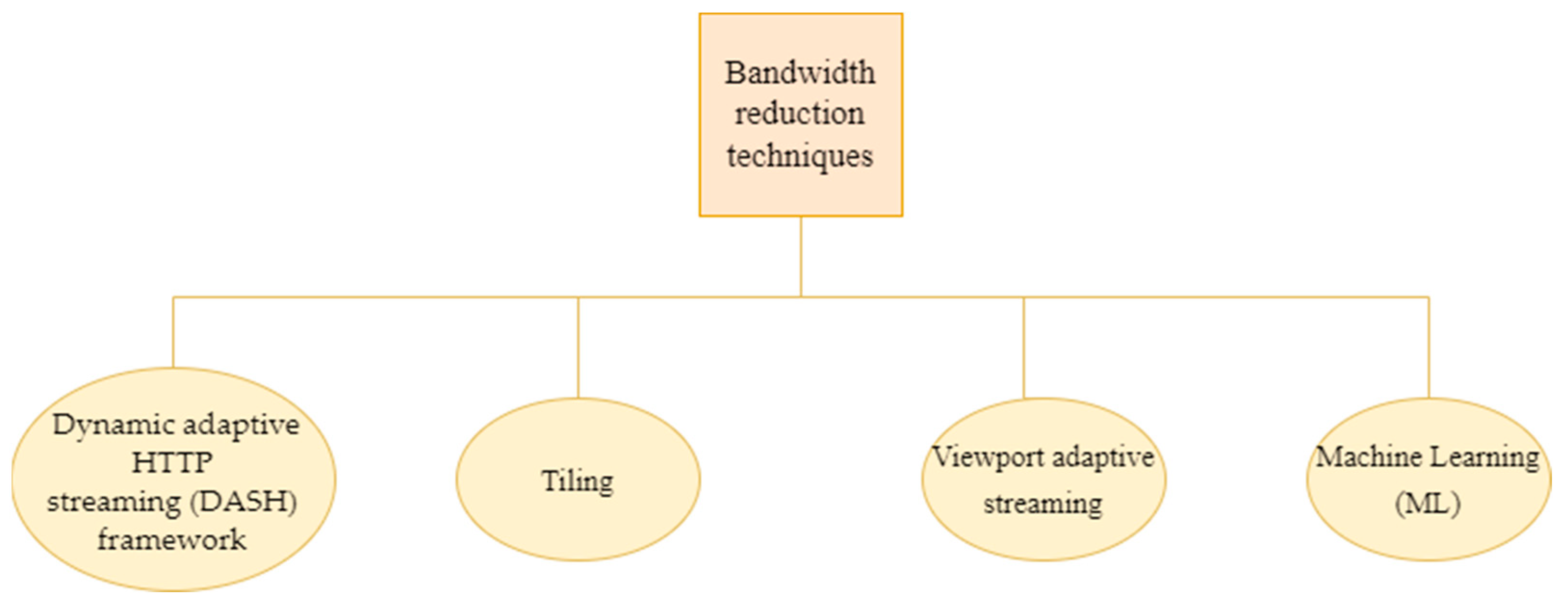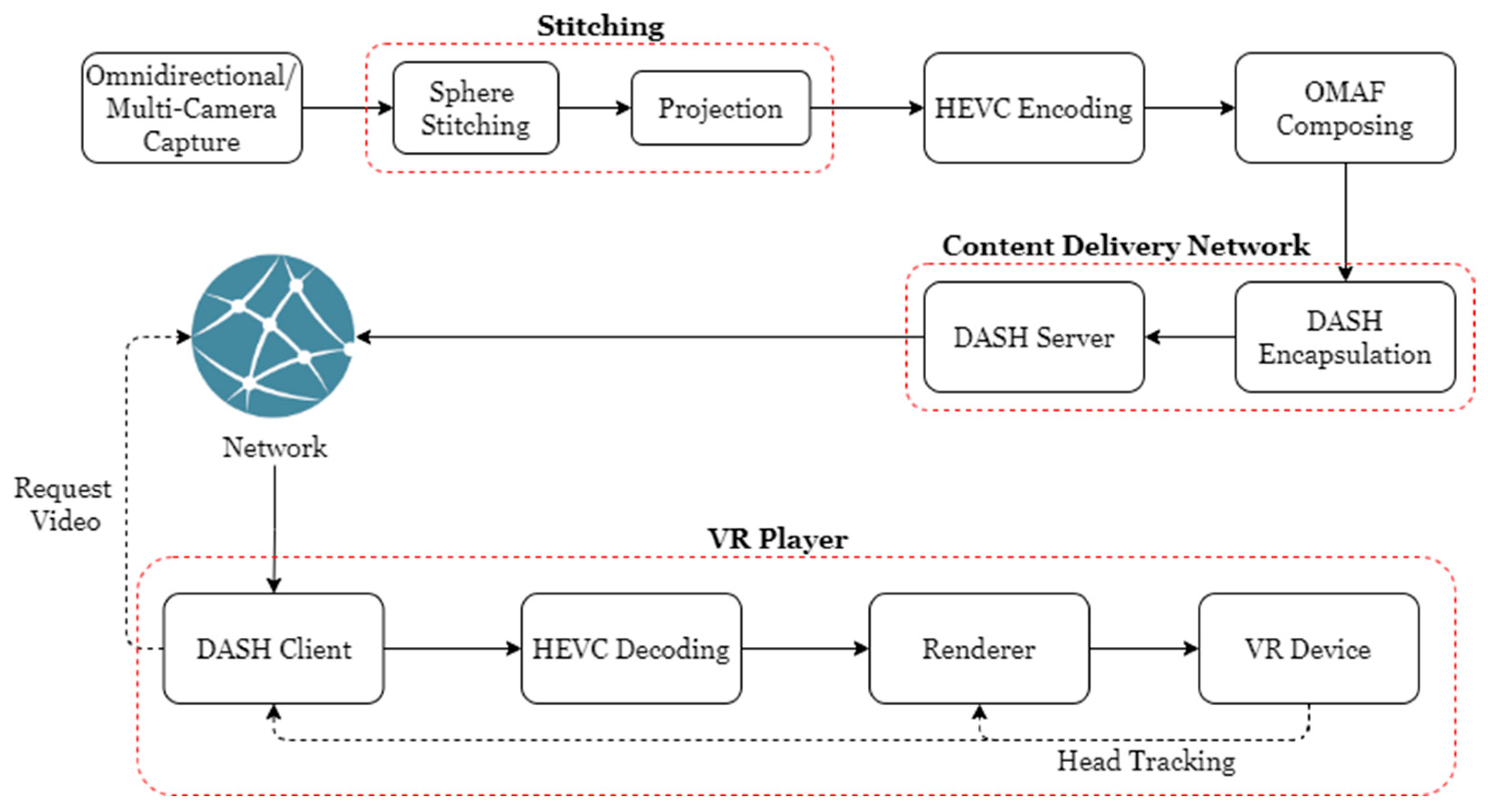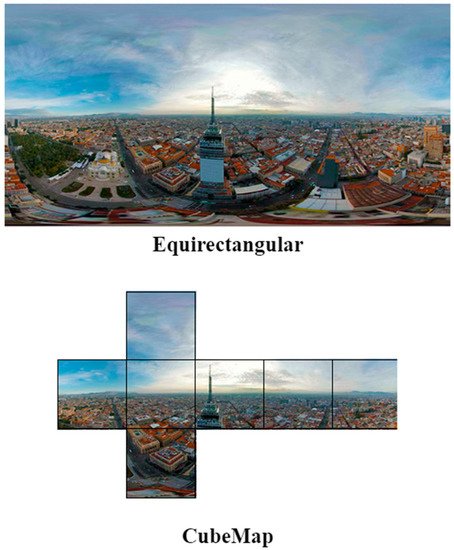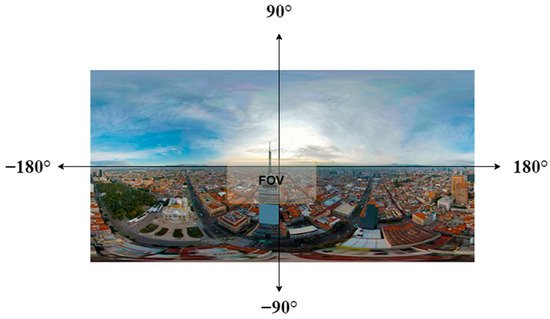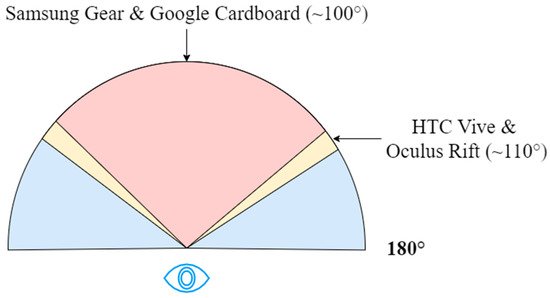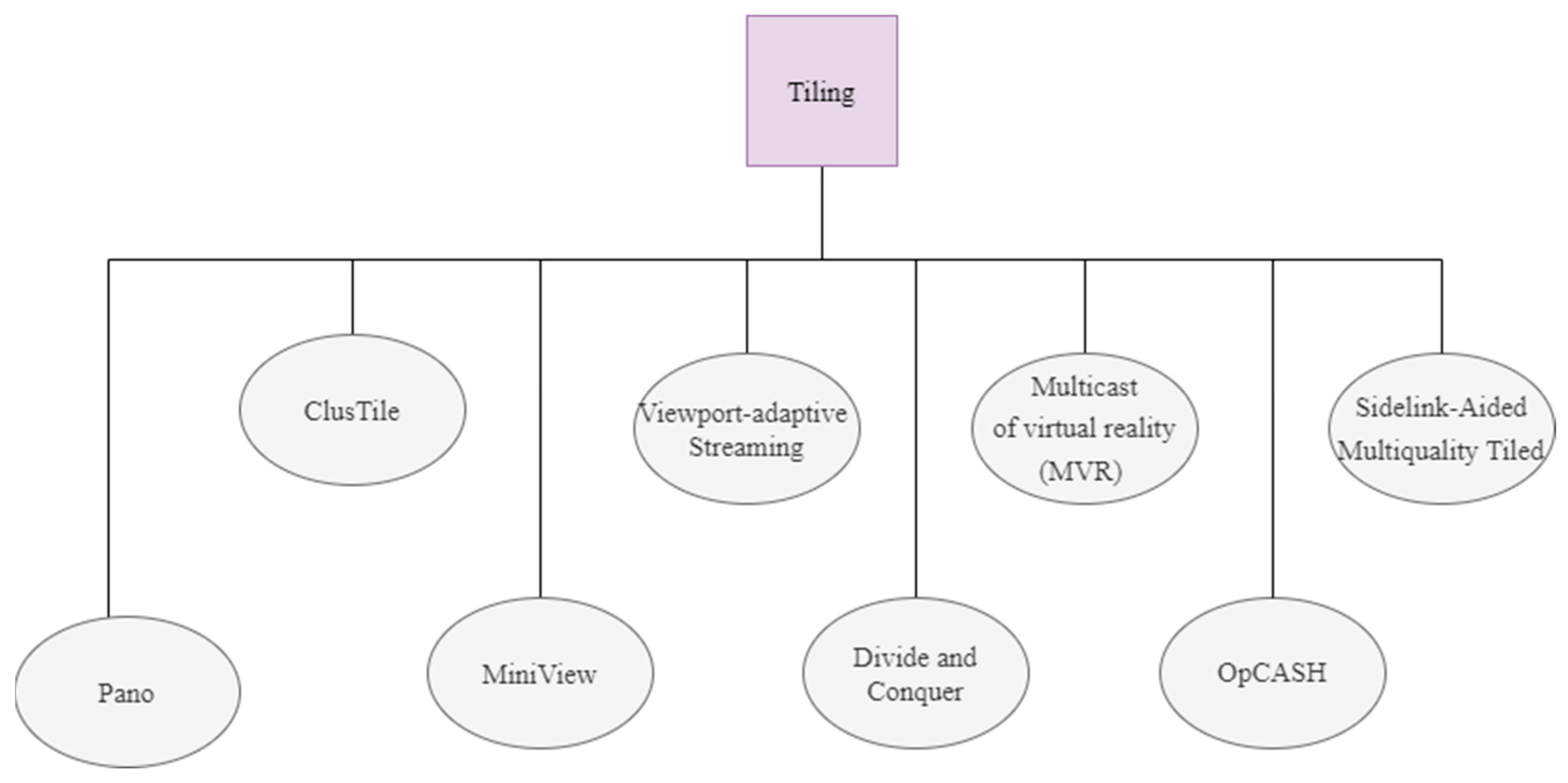1. Introduction
A 360-degree video is a video filmed in all directions by an omnidirectional camera or numerous cameras simultaneously, encompassing a whole 360-degree 3D sphere view, hence creating a Virtual Reality (VR) environment. When played back on a 2D flat screen (mobile or computer), viewers may alter the viewing direction and view the film from whichever angle they like, similar to a panorama. It can also be played on a display like a head-mounted display or projectors organized in the shape of a sphere or a portion of a sphere. The potential of 360-degree video and VR is enormous. The development of VR, AR and 360-degree video could be seen in education, real estate, medical, economics, and more.
The superiorities of 360-degree video can be concluded as: (a) Boost interest and creativity in education; (b) Generate various business and job opportunities in Metaverse; (c) Providing a virtual communication platform highly similar to face-to-face interaction; (d) Enabling a supreme experience in entertainment: games, concerts, etc.
Although lots of benefits can be listed on 360-degree video, there are a few problems such as lack of tools and network barriers. Due to the extremely high bandwidth demands, providing a great Quality of Experience (QoE) to viewers while streaming 360 videos over the Internet is particularly difficult. Both academics and businesses are currently looking for more effective ways to bridge the gap between the user experience of VR apps and the VR networking issues such as high bandwidth requirements.
Four categories of solutions proposed by various research are Dynamic adaptive HTTP streaming (DASH), tiling, viewport-adaptive, and Machine learning (ML), as illustrated in Figure 1.
Figure 1. Bandwidth reduction techniques.
2. Dynamic Adaptive HTTP Streaming (DASH) Framework
Dynamic adaptive HTTP streaming (DASH) is an MPEG standard that provides a multimedia style and specification for sending material over HTTP using an adjustable bitrate method
[1]. DASH is extremely compatible with the existing internet infrastructure due to its minimal processing burden and transparency to middleboxes, and the ability to apply alternative adaption methods makes it adaptable to diverse network conditions standard is generally extensively utilized for two-dimensional video streaming over the world wide web recently. DASH streaming works by splitting videos into short segments, each segment on the DASH server maintains a number of video streams with varying bitrates
[2]. By requesting the proper HTTP resource, based on the view on the streaming client, the main viewpoint segment stream with higher resolution and the other viewpoint segment stream with lower resolution. A video player can switch from one quality level to another in the middle of the video playback without interruption.
Table 1 demonstrates the major steps in the DASH streaming process:
Table 1. Major steps in the DASH streaming process.
Another extension of DASH or other streaming systems is the Omnidirectional Media Format (OMAF) standard specifying the spatial information of video segments
[4]. For the DASH OMAF scheme, storage space is sacrificed to increase the bandwidth of the VR video streaming
[5].
Figure 2 shows the technical framework of the DASH OMAF architecture network. Furthermore, OMAF specifies several requirements for users, bringing the standard specification for omnidirectional streaming one step closer to completion. Players based on OMAF have already been implemented and demonstrated
[6].
Figure 2. DASH-OMAF architecture network.
OMAF also defines tile-based streaming and Viewport-Based Streaming approaches where the Field of View (FoV) is downloaded at the highest quality possible, along with the lower quality of the other viewable region. This enables the client to download a collection of tiles with varying encoding qualities or resolutions, with the visible region prioritized to improve the quality of experience (QoE) while consuming less bandwidth.
Next, OMAF also specifies video profiles based on the High-Efficiency Video Coding (HEVC) coding standard, as well as HEVC-based or older Advanced Video Coding (AVC), AVC-based viewport-dependent profiles that support Equirectangular Projection (ERP), Cubic Mapping Projection (CMP), and tile-based streaming
[7]. The comparison of ERP and CMP is shown in
Figure 3.
Figure 3. Equirectangular projection (EMP) and cube map projection (CMP) comparison.
Clients can stream omnidirectional video from a DASH SRD or OMAF compliant server. The server will deliver segments with different viewport-dependent projections or independent tiles based on the choices of the client. The client then downloads the appropriate segments, potentially discarding low viewing probability segments or downloads with lower quality to save bandwidth. Next, the features of HEVC of fast Field of View (FoV) switching allow the client to request the segments based on users’ head movements in high quality
[8], users can even zoom into the region of interest within the 360-degree video
[9], providing a smooth user experience with minimal server-side changes.
In recent years, some researchers have enhanced the Quality of Experience (QoE) of 360 videos streaming with the DASH architecture
[10]. At any one point in a VR 360-degree movie, the user can at most see a portion of the 360-degree film. As a result, sending the entire picture wastes bandwidth and processing power. With the DASH-based viewpoint of adaptive transmission, these problems may be resolved. The client must pre-download the video material to ensure seamless playing, which needs the client predicting the user’s future viewpoint.
Based on HTTP 2.0, a real-time video streaming technology with low latency has been developed by Huang, Ding
[11]. The MPEG DASH prototype implements HTTP 2.0 server push functionality to actively deliver live video from the server to the client with low latency whereas Nguyen, Tran
[12] suggested an efficient adaptive VR video stream approach based on the DASH transport architecture via HTTP/2 that implements stream prioritization and stream termination.
3. Tiling
Tiling is one of the typical solutions proposed by various researchers in order to overcome the bandwidth issues of 360-degree videos by projecting and splitting video frames into numerous sections known as tiles. In general, this technique divides a frame into several sections known as tiles, focusing on the quality of the Region of interest (RoI)/Quality Emphasis Region (QER)/Field of View (FoV) while reducing the others to overcome the bandwidth issue. Most of the solutions are based on the DASH framework as discussed earlier.
Figure 4 illustrates the small region of FoV in an equirectangular mapped 2K picture. Following that, the most popular HMDs have a small FoV. For example, Google Cardboard
[13] and Samsung Gear VR
[14] have an FoV of 100 degrees whereas Oculus Rift and HTC Vive
[15] have wider 110 degrees of FoV as demonstrated in
Figure 5.
Figure 4. FoV in a full 360-degree video frame.
Figure 5. FoV associated with the human eye.
Figure 6 shows the methods using the tiling technique whereas Table 2 summarizes and compared the characteristics of each tiling scheme.
Figure 6. Methods using the tiling technique.
3.1. ClusTile
Research as Zhou, Xiao
[16] proposed ClusTile, a tiling approach that schemes each tile represents a DASH segment covering a portion of the 360-degree view with typically fixed time intervals, formulated by solving the set of integer linear programs (ILPs). Although this work mentions a decrease of such a high percentage in bandwidth reduction (76%), it does not allow varying the solution of representations but only their bitrate. The increasing number of tiles in the process is not sufficient for the segments downloaded and uploaded.
3.2. PANO
Guan, Zheng
[17] propose a quality model named Pano for 360° videos that capture the factors that affect the QoE of 360° video including difference in depth-of-field (DoF), relative viewpoint-moving speed and change in scene luminance. The proposed tiling scheme with variable-sized tiles aims to find the tradeoff between the video quality and efficiency of video encoding. Pano achieves 41–46% less bandwidth consumption than Zhou, Xiao
[16] with the same Peak Signal-to-Perceptible-Noise Ratio (PSPNR)
[17].
3.3. MiniView Layout
To reduce the bandwidth requirement of 360-degree video streaming, Xiao, Wang
[18] proposed the MiniView Layout which has saved up to 16% of the encoded video without downgrading the visual qualities. In this method, the video was projected into equalized tiles with each MiniView independently encoded into segments. It increases the number of segments and higher in the number of requests parallelly to the streaming client. Plus, Ref.
[18] showed improvements in projection efficiency as it created a set of views with the rectilinear projection referred to as “miniview”, which has smaller FOVs than cube faces, hence able to save encoded 360-degree videos’ storage size without quality loss. Each miniview has its parameters which include FOV, orientation and pixel density
[18].
3.4. Viewport Adaptive Streaming
In
[19], The adaption algorithm initially chooses the video’s Quality Emphasized Region (QER) based on the viewport center and the Quality Emphasis Center (QEC) of the available QERs. Each QER-based video is composed of a pre-processed collection of tile representations that are then encoded at various quality levels. This allows for faster server maintenance (fewer files, resulting in a smaller media presentation description (MPD) file), a simpler selection procedure for the client (through a distance computation), and no need to reconstruct the video prior to viewport extraction. However, improved adaption algorithms are required to predict head movement, as well as a new video encoding approach to do quality-differentiated encoding for high-resolution videos.
3.5. Divide and Conquer
Research by Hosseini and Swaminathan
[20] proposed a divide and conquer approach to increase the bandwidth efficiency of the 360 VR video streaming system. The hierarchical resolution degrading enables a seamless video quality-switching process hence providing a better user experience. Compared to the other method which uses equirectangular projection
[20], implements hexaface sphere projection as illustrated in (
[20] Figure 4), and significantly saved 72% bandwidth compared to other tiling approaches without viewport awareness. To improve the performance of this approach, an adaptive rate allocation method for tile streaming based on available bandwidth is needed.
3.6. Multicast Virtual Reality (MVR)
In
[21], the Multicast Virtual Reality (MVR) streaming technique, which is a basic rate adaptation mechanism, serves all members in a multicast group with the same data rate to ensure that all members can receive the video. The data rate is selected based on the member with the poorest network conditions. However, a better tile weighting technique with data-driven probabilistic and an improved rate adaption algorithm is required to improve the user experience.
3.7. Sidelink-Aided Multiquality Tiled
Dai, Yue
[22] adapt sidelink is a modification of the basic LTE standard that enables device-to-device (D2D) communication in 360-degree streaming without the use of a base station. Allocate tile weight based on long-term weight (how often the tile was visited) and short-term weight (tile distance from the FOV). To find suboptimal solutions with minimal computational cost, a two-stage optimization technique is used to pick sidelink Receivers and Senders in stage 1 and allocate bandwidth and select tile quality level in stage 2.
3.8. OpCASH
In
[23], a tiling scheme with variable-sized tiles is proposed. To deliver optimal cached tile coverage to user viewports (VP), Mobile Edge Computing (MEC) cache usage is used. Next, an ILP-based technique is used to determine the best cache tile configuration to decrease the redundancy of stored variable tiles at a MEC server while limiting queries to faraway servers, lowering delivery delay, and increasing cache utilization. OpCASH successfully reduces data fetched from content servers by 85% and overall content delivery time by 74% with MEC.
Table 2. Comparison of existing tiling approaches.
4. Viewport-Based Streaming
In the case of 360-degree video, it would be a waste of network resources to transmit the entire panoramic content as the users typically only see the scenes in the viewport. The bandwidth requirement can be decreased, and transmission efficiency could be improved by identifying and transmitting the current viewport content and the predicted viewport corresponding to the head movement of users. Similar to the tiling technique in the previous section, the server contains a number of video representations that range not just in bitrate but also in the quality of various scene areas. Then, the region of the viewport is dynamically selected and streams in the best quality while the other regions are in lower quality or not being delivered at all to reduce the bandwidth transmission. In other words, the highest bitrate is assigned to tiles in users’ viewports, while some other tiles possess bitrates that are proportionate to the likelihood that users may switch viewports, which is also similar to DASH. However, the number of adaption variants of the same content increases dramatically to smooth the viewport-switching due to the sudden head movements. As a result, storage is sacrificed, and the transmission rate increases.
Ribezzo, De Cicco
[24] proposed a DASH 360° Immersive Video Streaming Control System which consists of control logic with two cooperating components: quality selection algorithm (QSA) and view selection algorithm (VSA) to dynamically select the demanded video segment. The QSA functions similarly to traditional DASH adaptive video streaming algorithms whereas VSA aims to identify the proper view representation based on the current head position of the users. Ref.
[24] reduced segments bitrate around 20% with improved visual quality. In
[19], the adaptation algorithm first selects the Quality Emphasized Region (QER) of the video based on the viewport center and the Quality Emphasis Center (QEC) of the available QERs, hence providing high interactive service to head-mounted device (HMD) users with low management. However, improved adaption algorithms are required to predict head movement, as well as a new video encoding approach to do quality-differentiated encoding for high-resolution videos.
High responsiveness and processing power are required to adapt to rapid changes in viewports and viewport prediction to ensure smooth viewport switching with accurate prediction. Many viewport prediction approaches have been developed to cover the demands, such as historical data-driven probabilistic, popularity-based, deep content analysis, and so on as summarized in Table 3.
Table 3. Viewport prediction scheme of the viewport adaptive streaming approach.
5. Machine Learning
Machine learning (ML) is used to predict bandwidth and views as well as increase video streaming bitrate to improve the Quality of Experience (QoE)
[35].
Table 4 summarizes the many papers that use machine learning to increase QoE in video streaming applications. The proposed scheme in
[36] significantly reduces bandwidth consumption by 45% with less than a 0.1% failure ratio while minimizing performance degradation with Naïve linear regression (LR) and neural networks (NN). Next, Dasari, Bhattacharya
[37] developed a system called PARSEC (PAnoRamicStrEaming with neural Coding) to reduce bandwidth requirements while improving video quality based on super-resolution, where the video is significantly compressed at the server and the client runs a deep learning model to enhance the video quality. As for this, although Dasari, Bhattacharya
[37] successfully reduce the bandwidth requirement and enhance the quality of the video, deep learning is large in models. It also results in the slowest inference rate. Furthermore, Yu, Tillo
[38] present a method for adapting to changing video streams with the combination of the Markov Decision Process and Deep Learning (MDP-DL). In Filho, Luizelli
[39], a strategy for adapting to fluctuating video streams (the Reinforcement Learning (RL) model) is researched. Next, a Recurrent Neural Network-Long Short-Term Memory(RNN-LSTM) and Logistic Regression-Ridge Regression(LR-RR)) to predict bandwidth and viewpoint is researched by Qian, Han
[25] and Zhang, Guan
[40]. To increase QoE, Vega, Mocanu
[41] suggested a Q-learning technique for adaptive streaming systems. In
[42], the deep reinforcement learning (DRL) model uses eye and head movement data to assess the quality of 360-degree videos.
Table 4. Machine learning (ML)-based approaches.
Kan, Zou
[43] deploys RAPT360, a reinforcement learning-based Rate Adaptation with adaptable prediction and tiling for 360-degree video streaming, addresses the needs for precise viewport prediction and efficient bitrate allocation for tiles. Younus, Shafi
[44] presents an Encoder-Decoder based Long-Short Term Memory (LSTM) model that transforms data instead of receiving direct input to more correctly capture the non-linear relationship between past and future viewport locations to predict future user movement. To ensure that the 360 films sent to end-users are of the highest possible quality, Maniotis and Thomos
[45] propose a reactive caching scheme that uses the Markov Decision Process (MDP to determine the content placement of 360◦ videos in edge cache networks and then using the Deep Q-Network (DQN) algorithm, a variant of Q-learning to determine the optimal caching placement and cache the most popular 360◦ videos at base quality along with a virtual viewport in high quality.
6. Comparison between Techniques
Firstly, the DASH framework, tiling and viewport-adaptive techniques are correlated to each other as most of the tiling and viewport-adaptive techniques are using the DASH framework. Some of the tiling techniques
[16][19][20][21] and the viewport-adaptive approach
[28][31][32] are all using DASH to stream the areas covered by users’ FOV in high quality while some other tiles are streamed in lower quality. The differences between these techniques are the mapping projection, encoding, tiling scheme and tile selection algorithm.
However, there are several limitations to the tiling and viewport-adaptive method. Firstly, more bandwidth is required to stream a screen-size movie at viewport devices as compared to a typical 2D laptop screen at the same quality. As illustrated in
Figure 4, streaming a viewport region with a width of 110 degrees is still significantly wider than a normal laptop screen with a width of 48 degrees roughly
[3][35]. Furthermore, most tiling solutions employ the viewport-driven technique, in which only the viewport that is the viewed area of the viewer is streamed in high resolution, yet it may also suffer from a significant delay due to the switching of the viewport, which might be due to the video content from the other viewports are not being delivered at the moment. So, when the user abruptly switches his/her viewport during the display time of the current video segment, a delay occurs. Next, as human eyes have a low delay and error tolerance, any viewport prediction errors can cause rebuffering or quality degradation and result in a break of immersion and poor user Quality of Experience (QoE). Furthermore, to accommodate users’ random head movements, causing the need to increase the number of tiles of the video has and thus the video size increases significantly. Therefore, the implications of smooth viewport switching, minimized delays, with lessened video size and bandwidth should be addressed during 360-degree video delivery.
DASH, tiling and viewport-adaptive are focused on improving the streaming efficiency of the 360-degree video with lower bandwidth by streaming the demanded region of the 360-degree video with higher quality. On the other hand, Machine Learning (ML) techniques not only focus on lowering the bandwidth but also focusing on the improvement of QoE of the streaming. The proposed scheme ML also improves video quality, improves bitrate and predicts viewpoint in real-time which as is also effectively reduces bandwidth consumption while minimizing performance degradation. Some of the tiling and viewport-adaptive methods also use some algorithms such as Artificial Neural Network
[16], Heuristic algorithm
[21] and adaptive algorithm
[19] to optimize tile selection and predict the users’ viewpoint.

